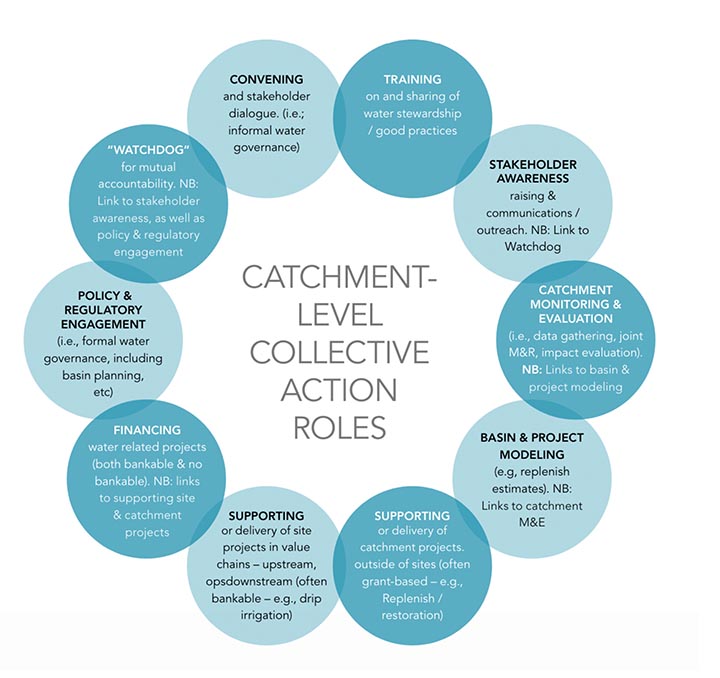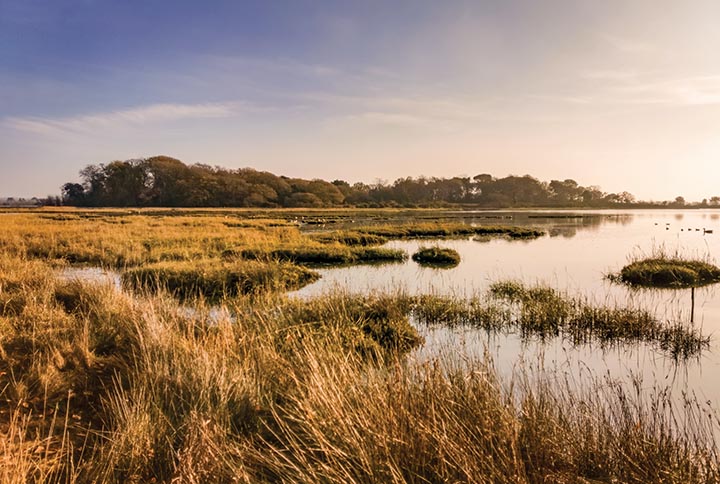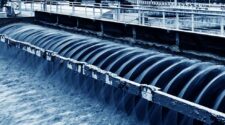Innovative Partnerships & Technology Implications
Since early 2023, several significant developments have occurred in addressing global water challenges. In particular, changes in corporate water strategy have driven innovation in partnerships and investments in water technologies.
An important place to start in understanding the intersection of corporate water strategy and technology innovation is to look back at the transition from corporate water management to water stewardship.
Over the last two decades, engagement by corporations on water issues has evolved from a focus on compliance and management to water stewardship. Water stewardship is now moving to a more sophisticated strategy integrated with business strategy, climate change, nature, and social impact issues, along with external engagement and reporting (ESG).
Water stewardship is a strategy to mitigate water-related risks within company operations and their supply chain and, in some cases, consumer-facing products (e.g., personal care products, washing machines, etc.). Stewardship initiatives typically include collective action programs and closely working with NGOs on watershed conservation projects linked to a company’s replenishment or net positive goals. Replenish, or net positive strategies, include offsetting a company’s operational and, in some cases, supply chain water footprint. Replenishment strategies seek to offset 100 percent of a company’s water footprint and net positive more than 100 percent.
Corporate water strategies are mostly now framed as replenish or net positive and focus on a company’s water footprint, essentially a “volumetric strategy.” This focus on replacing a company’s operational water footprint is now driving companies to develop innovative partnerships with other multinationals, NGOs, and water tech companies that save or reuse water.
The following three corporate water strategy initiatives (collective action, catalytic communities and nature) drive greater investment in innovative water technologies and direct engagement between corporations and technology startups/scale-ups.
Innovative Partnerships: Collective Action and Catalytic Communities
There is a “reboot” in collective action initiatives and also an emergence of “catalytic communities” as a new framework to accelerate impact in addressing wicked water problems at the watershed level.
Collective Action 2.0?
A recently released white paper, Unpacking Collective Action in Water Stewardship by WWF, frames the current state of collective action as a key element of corporate water stewardship. Most importantly, the white paper is the culmination of over a year of work by multinationals and NGOs to develop a more holistic and impactful framework to accelerate solutions to address watershed health and the loss of biodiversity.
WWF and the authors convey the urgent need to halt biodiversity decline and lack of access to clean water and sanitation. The facts are not encouraging; freshwater biodiversity continues to decline with a loss of 83 percent since 1970, and access to clean water and sanitation remains scant or non-existent for hundreds of millions of people. Climate change is a “threat multiplier,” making access to safe drinking water profoundly challenging and increasing biodiversity loss.
The white paper lays out a new model for collective action and addresses many of the challenges facing historical approaches to building and sustaining healthy watersheds.
While stakeholders have long recognized that working together can deliver greater impact for water, a common pool resource, there is also a recognition that in many cases, “efforts on collective action have remained fractured.” This white paper initiates a process to bring together NGOs, multinationals, and other civil society groups to be more effective in collective action programs.
A starting point in reframing collective action is clearly defining the diverse stakeholder categories and organizations with roles and responsibilities. Also central is to clearly articulate a commitment to collaborate with a common goal to increase impact in addressing water challenges (“wicked water problems”) –the authors representing diverse NGOs and other organizations committed to the following:
- Work together to accelerate collective action for sustainable water management in at-risk river basins and catchments.
- Operate through accessible, transparent, multi-stakeholder governance models at the catchment level and at other appropriate scales (e.g., municipal, national, regional, global), and coordinate collective action projects globally and locally by working as a community, where possible, via existing platforms.
- Identify a common set of collective action opportunity catchments as priorities for joint efforts and a shared implementation pathway for mobilization.
- Communicate to each other which roles we plan to undertake.
- Develop complementary projects and join forces on project delivery where appropriate.
- Seek to collectively build capacity and engage new actors across the required roles in collective action.
- Work to fund shared projects and grow the total funding jointly.
- Develop tools and resources that are complementary, work together, or can be used in conjunction with existing tools or resources.
- Collaborate on monitoring and sharing data on project outcomes.
- In all the places, we deploy collective action, work in an open and accessible manner, and engage local community members and indigenous peoples with respect for their local knowledge, culture, and traditions.”
The roles of these diverse stakeholders coming together to reinvigorate collective action to address the lack of access to safe drinking water and sanitation and biodiversity are illustrated in Figure 1.

Building upon these commitments and watershed (catchment) roles, the authors identified the high-priority areas to concentrate their efforts on. They identified over 350 high-opportunity catchments where they believe “collective action is not only needed but highly feasible given the concentration of economic activity and actors.” The authors also recommitted to revisiting shared efforts within these watersheds and identifying opportunities to coordinate efforts for increased impact.
In my view, the most important and hopefully impactful result of this effort is identifying new models for collaboration at the watershed level and sector scale. Ideas on new joint business models that can facilitate increased funding and deliver critical governance functions (I will get into new models in the next section). The authors vision a new way for collaboration modeled after a river system with the idea to aggregate funders “a common system (the headwaters), coordinating through common initiatives at the catchment level with a coordinated governance and funding allocation mechanism (the mainstem), and then re-distributing the sediment (money) to various projects (the delta). Common structures and incentive systems can help to align, convene, encourage public-private-civil coordination through formal and informal governance, and ultimately, grow the pie and scale impacts at the catchment scale.”
It is an interesting framework and a path forward for collective action.
Finally, the white paper outlines the next steps to move from a point of view and framework to action. The next steps consist of identifying a series of “collective action learning catchments,” continuing the dialogue on how to finance, operate, and recognize shared common water stewardship resource portals such as the Water Action Hub and the Alliance for Water Stewardship Tool Hub, building on common portals, and further mapping activity and initiatives on the ground to understand the picture better.
The goal is to “think beyond organizational boundaries and work, pre-competitively, towards the delivery of SDG6.”
In my view, this is an encouraging start to critically examine collective action to date and “reboot” to accelerate progress in addressing water challenges. By reinvigorating commitments to “solve water,” we can increase investment in innovative water technologies and nature-based solutions.
Catalytic Communities: A Collective Action Framework or a Step Beyond?

The first watershed-scale catalytic community was launched early this year. “Water United” focuses on the Colorado River Basin and has positively impacted how stakeholders collaborate to solve environmental and social challenges by creating catalytic communities.
To put catalytic communities in perspective, one needs to examine the role of collective action in water stewardship. Collective action has been central to addressing corporate water risks for decades. Collective action has delivered on its vision to facilitate cooperation and partnerships between the private sector, non-governmental organizations (NGOs), and other stakeholders.
Notable platforms include the CEO Water Mandate and the Beverage Industry Environmental Roundtable (BIER) programs. However, collective action initiatives are challenged to deliver on their full potential due to issues such as disparity in alignment and funding among stakeholders and a tendency for individual stakeholders to “go it alone.”
As noted in the previous section of this article, catalytic communities have emerged as complementary, if not alternative, to traditional initiatives due to the challenges facing collective action initiatives. Pursuing catalytic communities as a strategy may provide insights that can be integrated into current collective action initiatives.
One of the more important aspects of catalytic communities is the impact of commercial relationships between the stakeholders. It is increasingly clear that these commercial agreements provide alignment and speed to tackling “wicked water problems.”
The commercial relationships integrated into catalytic communities can be compared to how “catalytic capital” can jump-start longer-term strategies to address environmental and social issues.
Catalytic capital is crucial in fostering financial sustainability and scaling impact within communities. It provides patient, risk-tolerant, and flexible investments to unlock transformative solutions and mobilize additional capital toward underserved sectors or regions. The value of catalytic capital is briefly summarized below.
- Bridging Financing Gaps. One key advantage of catalytic capital is its ability to bridge financing gaps that conventional capital sources are unable or unwilling to address. This is particularly important for small and medium-sized enterprises (SMEs) in developing countries facing a significant $330 billion financing gap. By providing catalytic investments, these enterprises can access the necessary capital to grow, create jobs, and drive economic development within their communities.
- Enabling Innovative Business Models. Catalytic capital can also enable development and scaling of innovative business models that address social and environmental challenges. For example, catalytic investments in the affordable housing sector can support strategic collaborations and transformative business models that improve access to safe and affordable housing for vulnerable communities. Similarly, in the clean energy transition, catalytic capital can unlock financing for communities to participate by facilitating the adoption of solar power, electric vehicles, and other sustainable technologies.
- Attracting Mainstream Investors. Catalytic investments can help build a track record that attracts mainstream investors by providing initial risk-tolerant capital and demonstrating the viability of impact-driven ventures. This “catalytic effect” can mobilize additional capital towards initiatives that might have been deemed too risky or unconventional for traditional investors.
- Promoting Collaboration and Ecosystem Building. Catalytic capital initiatives often involve collaboration among stakeholders, including philanthropic investors, development finance institutions, fund managers, and intermediaries. This ecosystem-building approach fosters knowledge sharing, synergies, and collective efforts to effectively address critical social and environmental challenges.
In summary, catalytic capital is vital in promoting financial sustainability and scaling impact within communities by bridging financing gaps, enabling innovative business models, attracting mainstream investors, and fostering collaboration among diverse stakeholders.
Similarly, commercial relationships between stakeholders in catalytic communities create value and alignment for participating stakeholders while accelerating solutions to environmental and social challenges within watersheds (i.e., reducing or eliminating non-revenue water).
Commercial relationships are the cornerstone to building and scaling successful and impactful catalytic communities.
In my view, the most important and hopefully impactful result of this effort is identifying new models for collaboration at the watershed level and sector scale. Ideas on new joint business models that can facilitate increased funding and deliver critical governance functions.
Nature as a Corporate Sustainability Strategy
Nature emerged over the past year or so as a corporate sustainability focus area. While corporations have historically committed to reducing impacts to biodiversity, a nature strategy brings together several related issues – biodiversity, water, etc.
The emerging importance of nature as an element of a corporate sustainability strategy was evident at the GreenBiz Bloom 23: Where Biodiversity Meets the Bottom Line in October 2023. What started in 2022 as a half-day forum on biodiversity quickly grew into a stand-alone event that drew corporations, non-governmental organizations, investors, and start-ups. The number of technology companies struck me focused on addressing biodiversity loss and the number of corporations beginning to talk about their role in valuing and protecting nature. Investors are coming into play such as Superorganism, which is a new venture firm dedicated to startups that benefit biodiversity, and technology companies such as Nature Metrics, which provides data to measure and report on nature with scalable biodiversity monitoring and metrics powered by eDNA.
However, I was most moved by a presentation by Honorable Justice Joe Williams (Courts of New Zealand). Judge Williams clearly articulated that there is no separation between humanity and nature. We are nature and not separate from “the environment.” Interbeing is the elegant word coined by Zen Master Thich Nhat Hahn to describe the inter-connectedness of everything; separateness is an illusion. Judge Williams brings this to all aspects of life.
Judge Williams’ view aligns with my belief that water is not a “management issue” but an issue of “humanity’s relationship with water.” An initiative that moves us in this direction is the Freshwater Challenge Freshwater Challenge | WWF launched at UN-Water Week UN 2023 Water Conference. The Freshwater Challenge aims to ensure 300,000 km of degraded rivers and 350 million hectares of degraded wetlands are committed to restoration by 2030, and to protect freshwater ecosystems.
The Freshwater Challenge acknowledges that rivers and wetlands are at the center of water and climate impacts. These freshwater ecosystems are recognized as critical resources to be protected in international development frameworks, including the Sustainable Development Goals (SDGs), the UN Framework Convention on Climate Change (UNFCCC), the Convention on Biological Diversity (CBD), the UN Convention to Combat Desertification (UNCCD), the UN Decade on Ecosystem Restoration, the Ramsar Convention on Wetlands and the Sendai Framework for Disaster Risk Reduction.
The challenge with these frameworks is that action to protect these freshwater eco-systems needs to be faster. Rivers and wetlands need to be more valued and noticed, and their rapid loss undermines hard-won development gains and global efforts to tackle the climate and nature crises.
This is where the Freshwater Challenge comes in. It is a “country-led initiative that aims to support, integrate, and accelerate the restoration of 300,000 km of degraded rivers and 350 million hectares of degraded wetlands by 2030, as well as conserve intact freshwater ecosystems. Forty-six countries have joined the Freshwater Challenge so far.”
The Freshwater Challenge “aims to substantiate, integrate, and accelerate targeted interventions for rivers and wetlands, connecting these with national plans and strategies. It will increase the overall investment into the restoration and conservation of freshwater eco-systems and substantially increase the social and economic returns on those investments.”
An example of the Freshwater Challenge’s traction is the very recent launch of “The America the Beautiful Freshwater Challenge: A Partnership to Conserve and Restore America’s Rivers, Lakes, Streams, and Wetlands.” The initiative acknowledges that “U.S. lakes, rivers, streams, estuaries, and wetlands are fundamental to the health, prosperity, and resiliency of communities and are held sacred by many Tribal
Nations.”
The statistics in the U.S. are not encouraging. Over 50 percent of the nation’s wetlands in the Lower 48 states have been lost, and the American West is experiencing aridification. Also, nearly half of threatened and endangered species in the U.S. depend on wetlands, and more than 600,000 miles, or about 17% of our rivers, have been modified by large dams.
The goals of the America The Beautiful initiative are to:
- Reconnect, restore, and protect 8 million acres of wetlands by 2030, with an emphasis on forested, vegetated, peat soil, brackish, and tidal wetlands; and
- Reconnect, restore, and protect 100,000 miles of our nation’s rivers and streams by 2030, using approaches like removal of impediments and stream bank restoration.
Technology Implications and Investing
What do corporate water stewardship (collective action and catalytic communities) and a focus on nature mean for water technology companies and investing?
As corporations seek to achieve their ambitious replenishment or net positive goals and there is a movement to focus on nature through global initiatives such as the Freshwater Challenge, innovative technologies have now become an essential component of these strategies. This translates into corporations working with water technology companies and sometimes making direct investments in these companies.
Examples of corporate water strategy leading to new partnerships with water technology companies include Microsoft and PepsiCo.
Microsoft and FIDO Tech. In April 2023, Microsoft announced a partnership with FIDO Tech and Thames Water (Microsoft and FIDO Tech launch collaboration). This new partnership helps Microsoft make progress against its water replenishment goal, which is part of its overarching commitment to water positivity. FIDO’s technology has been deployed in London and across the Thames Water region to reduce water network losses through actionable AI in a first-of-its-kind replenishment project.
London’s water utility, Thames Water, has already committed to reducing its overall leakage to 20% by 2025 and halving leakage by 2050, but the average amount of water lost to pipeline networks globally is much higher. In 2020 Microsoft pledged to be water positive by 2030. This commitment is made up of five key pillars: reducing water use, replenishing water sources, providing people with access to water and sanitation services, advocating for effective water policy, and driving innovation and data digitization.
Melanie Nakagawa, Chief Sustain-ability Officer at Microsoft, said: “The global volume of non-revenue water, or freshwater that is lost due to leaks, is estimated to be 346 million cubic meters per day, amounting to 30% of water system input volumes across the world. Water data and new AI-powered tools can help address this challenge and have a tremendous impact on water solutions like leak detection.
This first-of-its-kind leak detection technology replenishment project in London with FIDO Tech will reduce water lost to leakage in London’s aging distribution network, leveraging FIDO’s AI-enabled acoustic leak analysis and is expected to save millions of cubic meters of water per year.”
PepsiCo and N-Drip. In 2022, PepsiCo and N-Drip announced a partnership to help farmers worldwide adopt game-changing technology in water efficiency across 10,000 hectares (25,000 acres) by 2025 (PepsiCo and N-Drip Partner to Provide Water-saving, Crop-enhancing Benefits to Farmers Around the World). A replacement for flood or trench irrigation, N-Drip’s high-efficiency irrigation system is powered by gravity. It harnesses the water-saving benefits of high-pressure drip irrigation but with low energy, operating and maintenance demands – making it more accessible to farmers and nearly all types of crops.
According to N-Drip, farmers routinely achieve significant water savings, see larger crop yields, and reduce the need for expensive fertilizers. In addition, by converting from flood irrigation to N-Drip’s drip irrigation system, carbon (CO2) emissions can be reduced by as much as 83 percent and methane emissions by as much as 78 percent.
PepsiCo sources over 25 crops across 60 countries and is an active leader in scaling and adopting regenerative farming practices under its pep+ (PepsiCo Positive) transformation. Leveraging its reach and network of farmers across its agricultural footprint, PepsiCo aims to scale N-Drip’s technology to help improve farmer livelihoods with higher yields, reduced water consumption, and reduced CO2 emissions. This effort will contribute to PepsiCo’s pep+ Positive Agriculture goals of improving direct agricultural supply chain water use efficiency by 15% by 2025 (against a 2015 baseline) in areas of high water risk, spreading regenerative agriculture practices across 7 million acres of farmland, and strengthening the livelihoods of more than 250,000 people in its agricultural supply chain.
“To date, we’ve implemented N-Drip’s technology with farmers in India, Vietnam, and the U.S., and saw improved crop yields, reduced fertilizer usage, and 50% less water consumed compared to flood irrigation,” said Rob Meyers, VP, Sustainable Agriculture, PepsiCo. “We’re thrilled to grow our partnership further by scaling N-Drip’s technology to make an even bigger impact across our agricultural footprint.”
Water Quality and Improving Access to Water
While historically water stewardship strategies have focused on reducing water use for a corporation across its supply chain and operations, there is an increasing interest in setting water quality goals and developing alternative sources of water. For example, Cargill’s Water Stewardship Strategy includes commitments to improve water quality and improve access to safe drinking water. Cargill is committed to:
- “By 2030, we will enable the restoration of 600 billion liters of water and reduction of 5,000 metric tons of water pollutants in water-stressed regions, and
- Enable improved access to safe drinking water and sanitation, reaching 500,000 people in priority communities.”
Their water stewardship strategy includes a commitment to deliver “reliable access to clean, safe water as well as sanitation and hygiene are essential for communities to thrive. While access to water and sanitation is improving globally, there are still parts of the world where limited access to safe drinking water is a local challenge.
Cargill is working to drive positive change, tailoring the specific needs of target communities in priority regions around the world. In partnership with global NGOs like CARE and Global Water Challenge, we’re working to enable improved access to safe drinking water and sanitation for 500,000 people.”
Path Forward
These water stewardship commitments along with reducing reliance on traditional sources of water (surface water and groundwater) are driving investments in water treatment technologies. Innovative treatment technologies to accelerate water reuse and deliver alternative sources of water (air moisture capture and desalination) will be essential for corporate water strategies going forward.
I believe many technologies exist to solve or at least tame water challenges. However, the challenge is funding and scaling these technologies at speed.
The private sector is in a unique position to be a catalyst for change by aligning their water and now nature strategies with direct engagement with innovative technology companies. In some cases NGOs will have a significant role in facilitating these corporate-technology partnerships.
Over the last year or so, there has been a noticeable shift in thinking about how to solve water problems. This is an encouraging trend.










